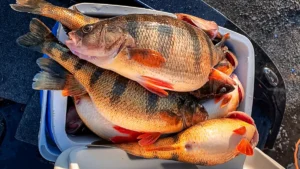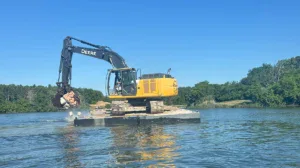Obsessed. Relentless. Defying logic. Mark Zona’s fixation with bass fishing really can’t be quantified. Though he doesn’t recommend it, Zona’s used his “death star” Nitro ZV21 as a chisel to break the ice to clear a path out to the lake more times than he’d like. He’s driven to find “the holy land” where young of the year bluegill congregate and the “wolves are right nearby.” And by wolves, we mean Northern Prespawn Bass.
Teenage Wisdom
It began as a teenager, when Zona studied copious collections of articles from premier publications suggesting where to look for cold-water largemouth bass. Problematically, they preached the merits of finding shad as the key to finding cold-water largemouth. Zona’s dilemma wasn’t easy because he grew up fishing in Illinois, Indiana, and Michigan, and there weren’t many shad.
Instead, Zona chased bluegills by drilling hundreds of holes through the ice to be rewarded with non-stop action while lucking into numbers of largemouth bass.
“I made mental notes of areas of every lake I went to where these spots were because when the ice came off, the bass would be there,” Zona said. Since Michigan didn’t have an early catch-and-release season as they do now, he studied Northern Indiana lakes by analyzing where ice fishermen targeted bluegill. He waited for “ice out” or made his path with his boat.
Hard work pays off. If you find them once, you’ll have these spots forever.
“They’re in the same spots year after year, decade after decade, which are predominantly wintering holes. So, these northern prespawn bass are like homing pigeons,” Zona said.
Anglers best be mentally prepared for the cold and dress accordingly; frigid air temperatures aren’t for the faint at heart.
“There’s nobody out there! I’m the only guy,” Zona said. “It is very hard to find these areas; I’m not going to sugarcoat that, but when you do find them, you’ll have them to yourself.”
The Science Lesson
The key is finding plumes of 2- to 5-inch bluegill that resemble palm trees on your electronics. Zona stresses that you’re looking for a needle in a haystack, but when you find them, you find everyone at the same party.
“Now, with live sonar technology, I believe that 80% of the biomass lives in a half dozen wintering holes, and the rest of the lake is devoid of any life at all,” Zona said.
It’s only been the past couple of years that Zona has been able to utilize live sonar, and until now, he painted a picture in his head from 2d sonar images about what was occurring.
“If I’m catching 50 to 100 bass, how many are there? MegaLive has proven that it is insane when you find these areas, the biomass of predator and prey and how many are there is staggering. When you find this deal going on, you don’t find dozens; you find hundreds of fish,” Zona said.
Using Humminbird Mega Side Imaging, Zona searches for the last living outside grass on a very slow tapering deep flat in 17- to 30- feet of water. What separates these pre-spawn wintering holes from what Zona calls “the holy land” is the combination of sand grass, also known as perch grass, where the broken bottom is mixed with sand.
Weather dramatically influences aquatic activity, especially during the cold-water months.
“Using Humminbird MegaLive, I see the bluegill plumes, and when it gets sunny, start roaming the flats. I can tell that these are biting bass because this is how these bluegills act,” Zona said.
Unfortunately, cloudy conditions foster inactivity among the bluegill and the bass that chase them. They’ll still bite in low-pressure situations, but Zona’s 100 fish days with big fish mixed resulted from 30- to 40-degree air temps and light wind.
This program excels in clear water. That isn’t to say that it will not work on lakes with stained or dirty water. Instead, look in shallower water because the grass needs light penetration to grow.
Zona’s systematic approach is simple yet complex; yes, that’s a contradiction of sorts. He stresses the importance of setting your boat up in shallower water and casting deep. Making every cast uphill is critical, and pointing his boat directly at the target area is critical.
There are three stages of the pre-spawn that Zona identifies by water temperature. Each tackle selection requires a precise cadence and presentation. Every bait selection through the various water temperatures is to match the immature life stage of the bluegill identically.
The key to be successful with the execution of his program is this: do not overwork your bait.
35 to 40 degrees—Fishing slow isn’t slow enough
A numbers game, this is when Zona catches some of the biggest fish of the year.
“Even though the bluegill will roam and suspend, a northern prespawn bass doesn’t like being very far off the bottom yet and is incredibly inactive,” Zona said. “Recently, I caught a half-dozen bass with clay coming off their stomachs. Those bass hadn’t moved in days, literally belly on the bottom.”
Blade Bait Gear:
- Homemade 1/2-ounce blade bait (chrome) with No. 6 Lazer Trokar EWG treble hooks
- Team Lew’s Mark Zona Swim Jig Rod, TLS76MH-SWJ
- Team Lew’s Pro-Ti SLP Series 7.5:1 casting reel
- 15-pound Seaguar Tatsu Fluorocarbon
Cast it out, let it get to the bottom, lift it, and drop it. “It’s a very soft pull. I lift, and the rod loads when they bite it,” Zona said. “When I feel the initial vibration from lifting it which might only be 18 inches, I set it back down. If you let it sit on the bottom for 5 to 10 seconds, your catches will increase by three to one.”
Jig and Minnow Gear:
- Strike King Baby Z-Too (Arkansas Shiner)
- 1/4-ounce homemade Ned head
- 7-foot Team Lew’s Mark Zona All-Purpose Spinning Rod, TLS70MXFS
- Custom Lew’s Light 200 spinning reel
- 10-pound Seaguar Smackdown
- 6- to 8-pound Seaguar Tatsu leader
Admittedly, Zona isn’t wired with the patience to fish a Ned Rig, but once it started outproducing the blade bait, he keeps it in his hands 75% of the time. He credits this discovery to his boys, Hunter and Jakob.
The unassuming neutral action of a Baby Z-Too rigged on a Ned head is too much for largemouth to resist. The key is getting this bait far away from these schools.
“Even though I’m fishing deep, these fish are boat shy,” Zona said. “All I’m doing is getting this bait to the bottom, purposely hooking grass and quivering my bait by barely pulsing the rod tip- and killing it. Before I know it, the rod loads. I do not feel them bite it. The only time I feel them bite it is when they’re competitive, and still, it’s more of a light thump.”
40-45 Degrees—Triggering Prespawn Bass
As the water temperature slowly warms, Zona imparts more action to entice bites, now scooting a soft-plastic swimbait along the bottom. Once the largemouth feed more aggressively, he’ll retrieve the bait within 2 feet of the bottom. Zona can drive the hook home from farther distances by opting for a more powerful spinning rod, especially since he’s fishing a heavier head.
“By studying MegaLive, I know that bass will track a bait a lot longer in cold water than I thought before they commit,” Zona said.
He’ll alternate between the swimbait and a downsized tube. He’s never had luck fishing a larger tube until the water warms into the next phase of his program.
Swimbait and Tube Gear:
- Strike King Rage Swimmer 3.25 (Ayu)
- prototype 3/8-ounce prototype jig head
- Strike King Coffee Tube 2.75 (KVD Kick and Green Pumpkin/Purple Flake)
- 5/16-ounce Strike King Bitsy Crackin’ Tube Head
- Team Lew’s Mark Zona Tube Crackin’ Special, TLS72MXFS
- Lew’s Custom Lite 200 spinning reel
- 10-pound Seaguar Smackdown
- 20-foot leader of 8-pound Seaguar Tatsu
45-50—Getting Northern Prespawn Bass Fired Up
As the water temperatures warm into this range, sunlight significantly increases bluegill activity. On these beautiful days, bluegill get higher in the water column, and northern prespawn bass lurk beneath them and suspend. Mix in a little bit of wind and let the action begin.
“Now I can get fish to rise and hit a bait”, Zona said. “If I’m holding my boat in 14 feet of water and throwing to 21, I can get that jerkbait to sink to 12- to 13- feet of water. I’m gonna hurt big ones.”
Zona employs some tricks to keep the jerkbait deeper in the water column. Working the bait on 10-pound Seaguar Tatsu while adding #4 Trokar EWG hooks are imperative. Zona adds Storm SuspenStrips to keep the bait down in the water column once it achieves the desired depth.
Zona cautions that this isn’t the time of year to be ripping a jerkbait.
“It’s a side sweep, and I’m only moving it 2 feet at most a time. It’s still cold water. I don’t catch them jerking; I catch them pulling my jerkbait.”
Jerkbait Gear:
- Strike King KVD 300 Jerkbait (Clearwater Minnow and Crystal Shad)
- Lew’s KVD 6’10” Signature Series rod
- Lew’s Custom Lite Reel (7:5;1)
- 10-pound Seaguar fluorocarbon line
When they won’t rise to hit a jerkbait, Zona opts for a larger tube jig and switches his setup to “crack ’em.” Many Northern anglers find success working a tube jig in its place by popping the rod tip of a medium action rod while working a fluorocarbon line. The stretch and soft tip allow the tube jig to hop off the bottom without the overtly erratic action created when fishing braided line. Early in the season, Zona struggles to get northern prespawn bass to eat a larger tube, but they will at this temp. He’ll also upsize his spinning reel to launch the bait as far as possible.
Tube Gear:
- Strike King Coffee Tube 3 1/2 inch (Green Pumpkin/Purple Flake and KVD Kick)
- 3/8-ounce Strike King Bitsy Crackin’ Tube Head
- Team Lew’s Mark Zona Tube Crackin’ Special, TLS72MXFS
- Lew’s Custom Lite 300 spinning reel
- 8-pound Seaguar Tatsu fluorocarbon








![[VIDEO] Greg Hackney’s Formula for Post-Spawn Bass Success](https://www.wired2fish.com/wp-content/uploads/2025/05/Hackney_Post-Spawn_Bass-300x169.webp)
![[VIDEO] Scanlon’s Guide for Stained Water Spawning Bass](https://www.wired2fish.com/wp-content/uploads/2025/05/scanlon-jig-300x169.webp)
![[VIDEO] Seth Feider’s Prespawn Jig Pattern Explained](https://www.wired2fish.com/wp-content/uploads/2025/04/prespawn-jig-300x169.webp)









